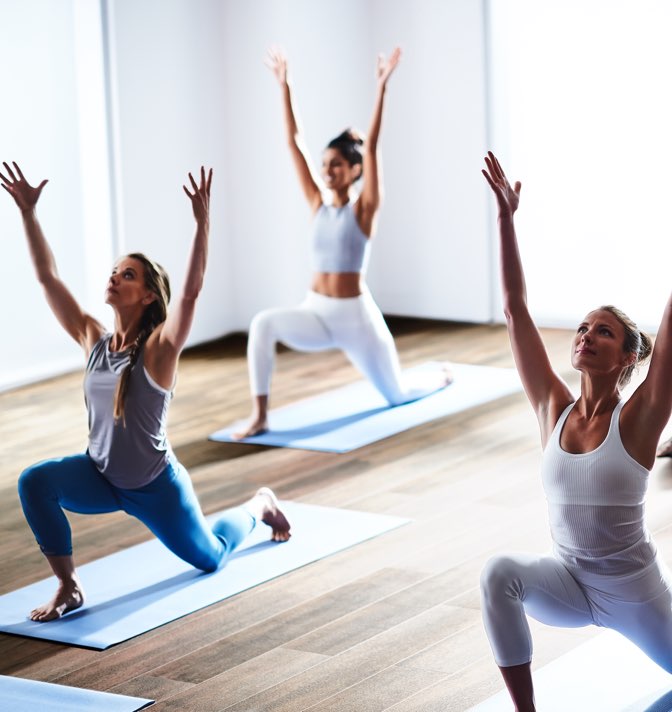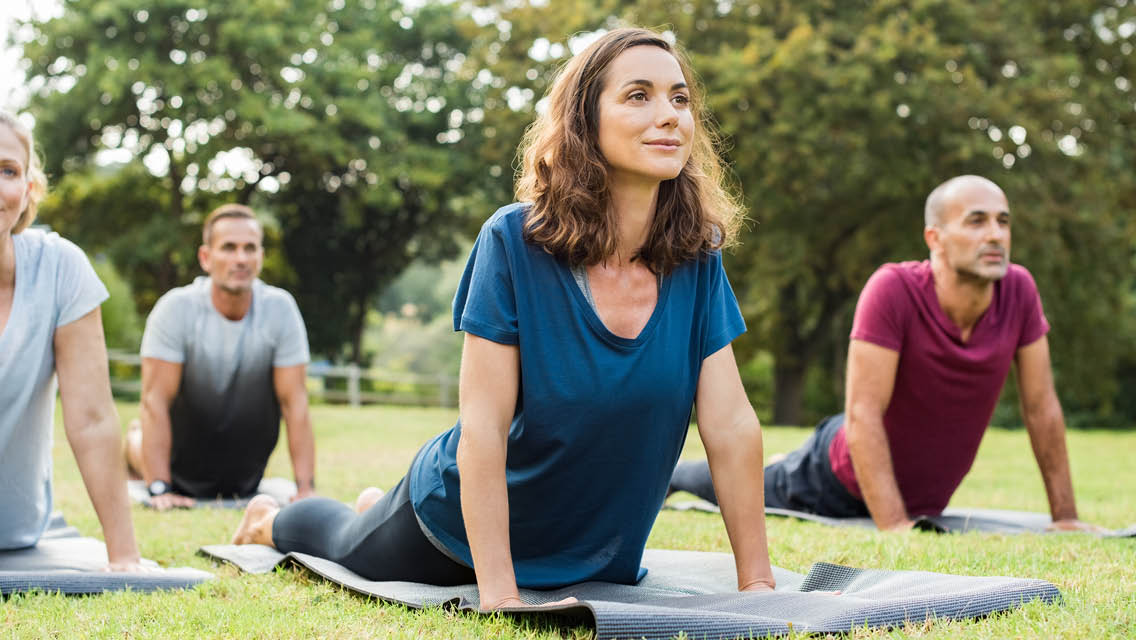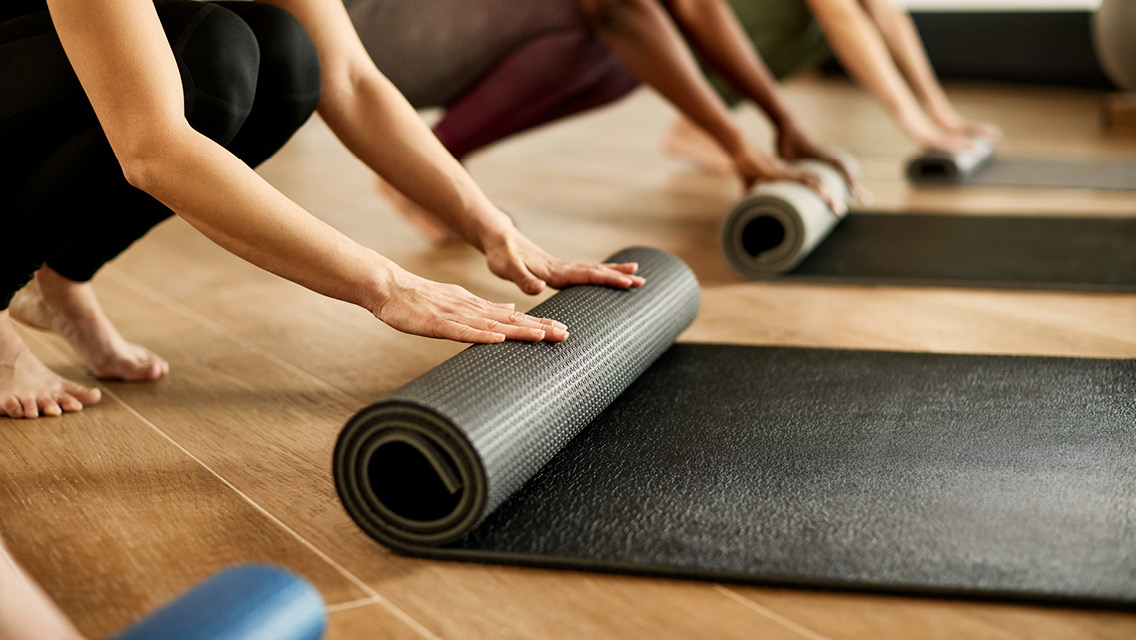Fitness trends come and go, rarely translating to sustainable workout habits or routines built on a foundation of consistency, compassion, and accessibility. And with so much information coming from so many different directions, it can sometimes be difficult to cut through the noise.
To help set you on the path to long-term health and wellness, here are five fitness movements worth exploring for their potential to shift the conversation toward personalization, accessibility, and sustainability.
1) In-Real-Life Training
With the closure of health clubs in 2020 — and the rise of at-home workouts throughout the pandemic — it was easy to wonder what the future would hold for in-person training. The answer, it turns out, is a resurgence.
Visits to gyms in January 2023 increased by 28.9 percent compared with the same period in 2022. Not only have visits rebounded to prepandemic levels, but people tend to stay at the gym longer than they did in 2019.
Why the revival? Real-life, real-time training offers benefits that are harder to achieve through virtual workouts at home.
One is community. While virtual platforms typically include online support groups to help patrons meet their goals, in-person group fitness classes are often fertile ground for developing friendships and building accountability. Studies have shown that having a workout buddy who knows your goals and supports you in establishing a new habit can lead to lasting change.
Another benefit is safety. In-person instructors can spot form issues and offer modifications. Live training also typically includes a warm-up and cool-down, which are essential for maintaining your heart health but easy to skip without a coach.
But, if at the end of the day you still prefer virtual and hybrid training, don’t fret: Those options aren’t going anywhere. Consider IRL training one more option for moving your body in the way that works best for you.
2) Immersive Virtual Experiences
The next gen of virtual workouts is designed to make you feel like you’re anywhere but home. Virtual reality (VR) tech combines the elements of gaming and fitness with immersive backdrops.
Beat Saber allows you to fight mysterious futuristic objects using lightsabers; Thrill of the Fight hands you virtual boxing gloves; and Supernatural offers coach-led fitness classes in far-flung destinations. HoloBall and Holopoint replicate racquetball and archery. Goalkeeper, meanwhile, has you deflecting balls on a virtual soccer pitch.
“Its immersive quality is what makes VR training magical,” says Leanne Pedante, the head of fitness at Supernatural. “We’re giving people the ability to work out at home but also get out of their own setting.”
VR training can also make at-home fitness more accessible and adaptive, she adds. Supernatural, for instance, allows users to turn off squat mode or activate one-controller mode, accounting for injury or disability.
“This degree of accessibility is usually only available to someone with a personal trainer,” she says. “These adaptations are huge.”
3) Low-and-Slow Exercise
Users on TikTok and other social-media platforms have recently generated a lot of energy around low-impact, low-intensity training, reminding us that taking leisurely walks and doing gentler forms of yoga, Pilates and barre can feel pretty great while still delivering myriad health and fitness benefits.
The accessibility of activities that moderately elevate the heart rate and build strength — with less impact on joints and stress hormones — is heartening for new and experienced exercisers alike, says Life Time director of fitness Jessie Syfko, CSCS, RYT, ND.
“Don’t mistake low impact for easy. In most cases, slowing down is more difficult because you have to feel and breathe your way through an entire range of motion.”
It’s a great starting point for beginners and can also help hard-hitting athletes mix up routines and improve recovery.
“Just don’t mistake low impact for easy,” Syfko warns. “In most cases, slowing down is more difficult because you have to feel and breathe your way through an entire range of motion.”
This change of pace can be humbling for people accustomed to the high-intensity interval training (HIIT) and boot-camp workouts that have dominated fitness in recent years. But lifting your foot off the accelerator — even occasionally — is well worth it.
(Learn more about the benefits of low-impact training at “The Case for Low-Impact Exercise.”)
4) Next-Gen Wearables
In addition to the ever-evolving wrist-worn fitness trackers, wearable-tech companies are now making gear accessible to people who can’t, or don’t want to, wear a tracker in watch form.
Oura rings, for instance, open up an alternative wearable option for tracking sleep, stress, steps, and more. And Whoop is set to roll out a new generation of its clothing line featuring pieces that can collect biometric data from the waist, torso, calf, and biceps.
Despite these technological advances, it’s worth noting that fitness tracking is not for everyone. Too much data can increase the pressure to self-optimize — a slippery slope that can damage mental health — and raise privacy issues.
“My advice is not to let the data become the goal,” says Christopher Lundstrom, PhD, MEd, a lecturer at the University of Minnesota’s School of Kinesiology. “The goal is feeling good and improving your health. This information can help support that, but don’t let the data become too important or too much of a driver for you.”
(For more fitness-tracker pros and cons, visit “Fitness Data Explained.”)
5) Mind–Body Training
It’s no secret that living a movement-filled lifestyle strengthens more than our muscles. “It strengthens our immune systems and mental health, and it helps us create a relationship to self-care that can change our entire lives,” says Syfko.
This holistic perspective has led to a rise in mind–body approaches to group fitness and personal training. Meditation, mobility, functional strength, and intentional conditioning are increasingly common components of fitness plans.
An example of such a mind–body training program is Life Time’s MB360. This program, developed by Syfko, is designed to train people “to set up all movement with a growth mindset, which is the foundation that supports optimal movement patterns and longevity of all their favorite activities.”
This approach puts aside the pressure to keep up with the Joneses (or the Kardashians) and reminds us that exercise isn’t only about aesthetics. Instead, it’s a celebration of our humanity, showing up, embracing our good and bad days, and building community around sustainable exercise routines and the pursuit of longevity.
“As the seasons of your life change, so should your workouts,” says Syfko. Mind–body training can empower you to “tap into and understand your body and what it needs today, not yesterday or 20 years ago.”






This Post Has 0 Comments